head light CHEVROLET CAMARO 1967 1.G Chassis Owner's Guide
[x] Cancel search | Manufacturer: CHEVROLET, Model Year: 1967, Model line: CAMARO, Model: CHEVROLET CAMARO 1967 1.GPages: 659, PDF Size: 114.24 MB
Page 547 of 659
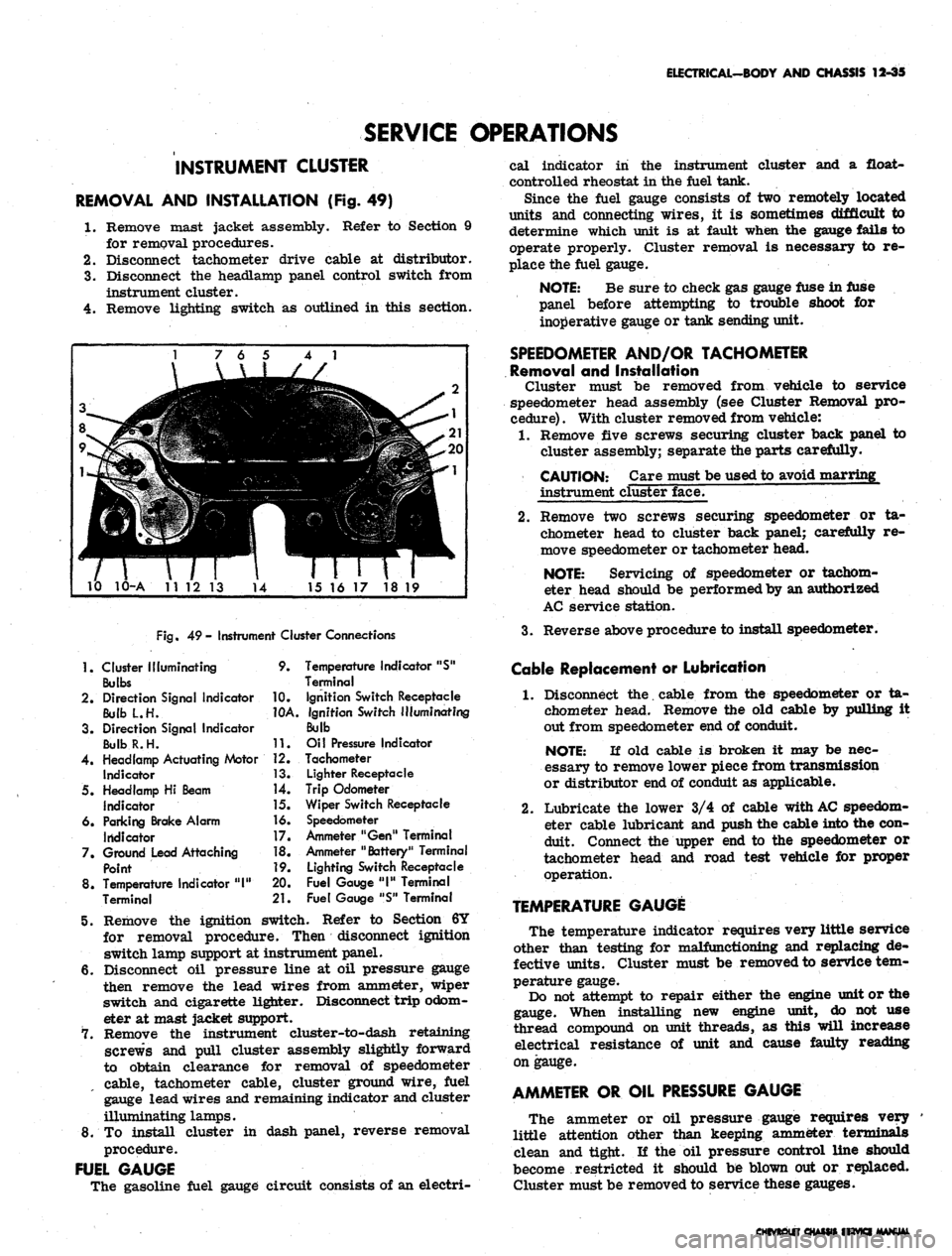
ELECTRICAL-BODY AND CHASSIS 12-35
SERVICE OPERATIONS
INSTRUMENT CLUSTER
REMOVAL AND INSTALLATION (Fig. 49)
1.
Remove mast jacket assembly. Refer to Section 9
for removal procedures.
2.
Disconnect tachometer drive cable at distributor.
3.
Disconnect the headlamp panel control switch from
instrument cluster.
4.
Remove lighting switch as outlined in this section.
10 10-A 1112 13
14
15 16 17 18 19
Fig.
49- Instrument Cluster Connections
1.
Cluster Illuminating
Bulbs
2.
Direction Signal Indicator
Bulb L.H.
3. Direction Signal Indicator
BulbR.H.
4.
Headlamp Actuating Motor
Indicator
5. Headlamp Hi Beam
Indicator
6. Parking Brake Alarm
Indicator
7. Ground Lead Attaching
Point
8. Temperature Indicator
"1"
Terminal
9.
10.
10A.
11.
12.
13.
14.
]5.
16.
17.
18.
19.
20.
21.
Temperature Indicator "S"
Terminal
Ignition Switch Receptacle
ignition Switch Illuminating
Bulb
Oil Pressure Indicator
Tachometer
Lighter Receptacle
Trip Odometer
Wiper Switch Receptacle
Speedometer
Ammeter "Gen" Terminal
Ammeter "Battery" Terminal
Lighting Switch Receptacle
Fuel Gauge
"1"
Terminal
Fuel Gauge "S" Terminal
5. Remove the ignition switch. Refer to Section 6Y
for removal procedure. Then disconnect ignition
switch lamp support at instrument panel.
6. Disconnect oil pressure line at oil pressure gauge
then remove the lead wires from ammeter, wiper
switch and cigarette lighter. Disconnect trip odom-
eter at mast jacket support.
7. Remove the instrument cluster-to-dash retaining
screws and pull cluster assembly slightly forward
to obtain clearance for removal of speedometer
cable, tachometer cable, cluster ground wire, fuel
gauge lead wires and remaining indicator and cluster
illuminating lamps.
8. To install cluster in dash panel, reverse removal
procedure.
FUEL GAUGE
The gasoline fuel gauge circuit consists of an electri-
cal indicator in the instrument cluster and a float-
controlled rheostat in the fuel tank.
Since the fuel gauge consists of two remotely located
units and connecting wires, it is sometimes difficult to
determine which unit is at fault when the gauge fails to
operate properly. Cluster removal is necessary to re-
place the fuel gauge.
NOTE:
Be sure to check gas gauge fuse in fuse
panel before attempting to trouble shoot for
inoperative gauge or tank sending unit.
SPEEDOMETER AND/OR TACHOMETER
Removal and Installation
Cluster must be removed from vehicle to service
speedometer head assembly (see Cluster Removal pro-
cedure)
.
With cluster removed from vehicle:
1.
Remove five screws securing cluster back panel to
cluster assembly; separate the parts carefully.
CAUTION: Care must be used to avoid marring
instrument cluster face.
2.
Remove two screws securing speedometer or ta-
chometer head to cluster back panel; carefully re-
move speedometer or tachometer head.
NOTE:
Servicing of speedometer or tachom-
eter head should be performed by an authorized
AC service station.
3.
Reverse above procedure to install speedometer.
Cable Replacement or Lubrication
1.
Disconnect the. cable from the speedometer or ta-
chometer head. Remove the old cable by pulling it
out from speedometer end of conduit.
NOTE:
If old cable is broken it may be nec-
essary to remove lower piece from transmission
or distributor end of conduit as applicable.
2.
Lubricate the lower 3/4 of cable with
AC
speedom-
eter cable lubricant and push the cable into the con-
duit. Connect the upper end to the speedometer or
tachometer head and road test vehicle for proper
operation.
TEMPERATURE GAUGE
The temperature indicator requires very little service
other than testing for malfunctioning and replacing de-
fective units. Cluster must be removed to service tem-
perature gauge.
Do not attempt to repair either the engine unit or the
gauge. When installing new engine unit, do not use
thread compound on unit threads, as this will increase
electrical resistance of unit and cause faulty reading
on gauge.
AMMETER OR OIL PRESSURE GAUGE
The ammeter or oil pressure gauge requires very
little attention other than keeping ammeter terminals
clean and tight. If the oil pressure control line should
become restricted it should be blown out or replaced.
Cluster must be removed to service these gauges.
HftVKI MANUAL
Page 548 of 659
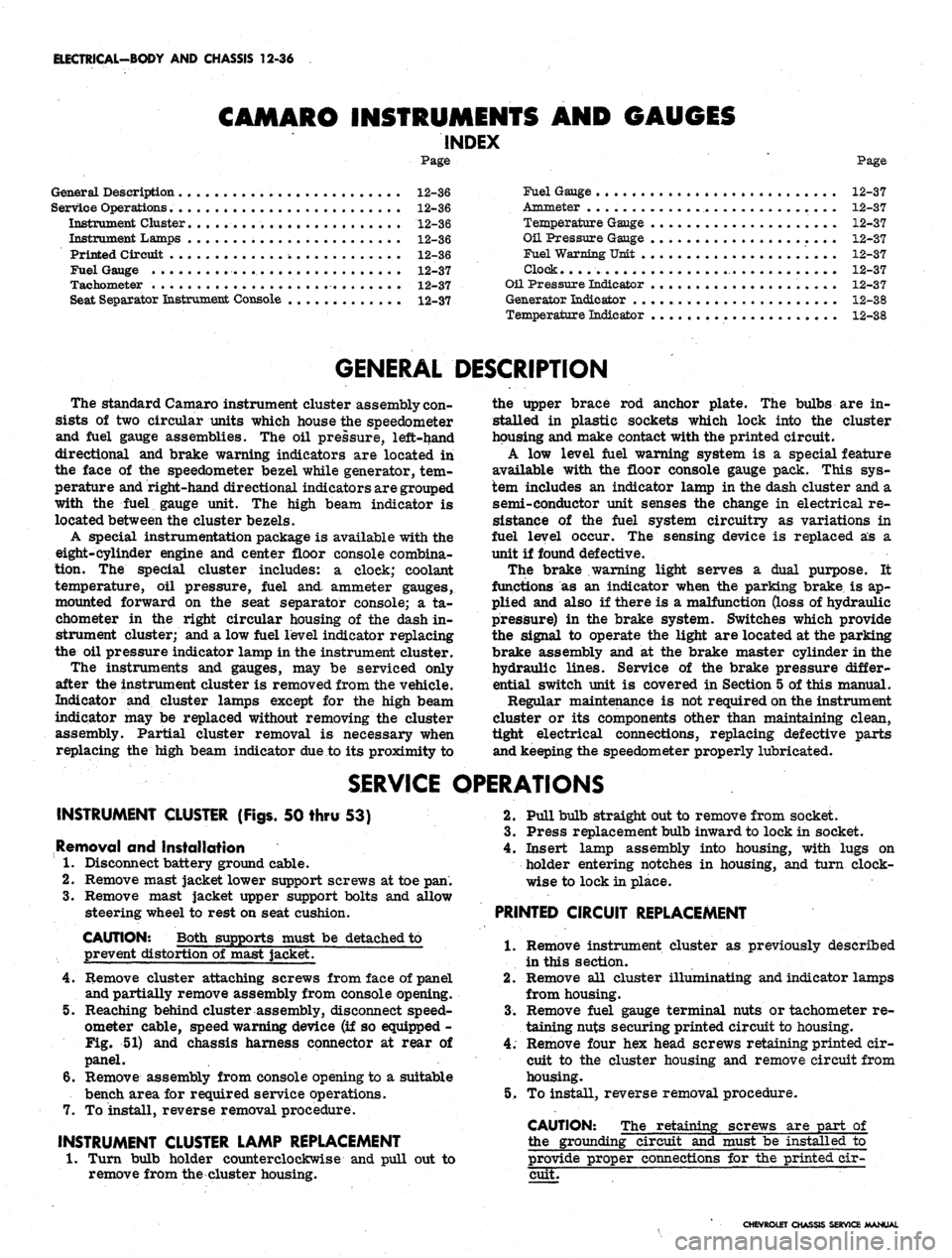
ELECTRICAL-BODY
AND
CHASSIS
12-36
CAMARO INSTRUMENTS AND GAUGES
INDEX
Page
General Description
12-36
Service Operations
12-36
Instrument Cluster
. . . 12-36
Instrument Lamps
12-36
Printed Circuit
12-36
Fuel Gauge
12-37
Tachometer
. . 12-37
Seat Separator Instrument Console
12-37
Page
Fuel Gauge
12-37
Ammeter
12-37
Temperature Gauge
12-37
Oil Pressure Gauge
. 12-37
Fuel Warning Unit
12-37
Clock.
... 12-37
Oil Pressure Indicator
12-37
Generator Indicator
12-38
Temperature Indicator
12-38
GENERAL DESCRIPTION
The standard Camaro instrument cluster assembly con-
sists
of two
circular units which house
the
speedometer
and fuel gauge assemblies.
The oil
pressure, left-hand
directional
and
brake warning indicators
are
located
in
the face
of the
speedometer bezel while generator,
tem-
perature
and
right-hand directional indicators are grouped
with
the
fuel gauge unit.
The
high beam indicator
is
located between
the
cluster bezels.
A special instrumentation package
is
available with
the
eight-cylinder engine
and
center floor console combina-
tion.
The
special cluster includes:
a
clock; coolant
temperature,
oil
pressure, fuel
and
ammeter gauges,
mounted forward
on the
seat separator console;
a ta-
chometer
in the
right circular housing
of the
dash
in-
strument cluster; and
a low
fuel level indicator replacing
the
oil
pressure indicator lamp
in the
instrument cluster.
The instruments
and
gauges,
may be
serviced only
after
the
instrument cluster
is
removed from
the
vehicle.
Indicator
and
cluster lamps except
for the
high beam
indicator
may be
replaced without removing
the
cluster
assembly. Partial cluster removal
is
necessary when
replacing
the
high beam indicator due
to its
proximity
to
the upper brace
rod
anchor plate.
The
bulbs
are in-
stalled
in
plastic sockets which lock into
the
cluster
housing and make contact with
the
printed circuit.
A
low
level fuel warning system
is a
special feature
available with
the
floor console gauge pack. This
sys-
tem includes
an
indicator lamp
in the
dash cluster and
a
semi-conductor unit senses
the
change
in
electrical
re-
sistance
of the
fuel system circuitry
as
variations
in
fuel level occur.
The
sensing device
is
replaced
as a
unit
if
found defective.
The brake warning light serves
a
dual purpose.
It
functions
as an
indicator when
the
parking brake
is ap-
plied
and
also
if
there
is a
malfunction (loss
of
hydraulic
pressure)
in the
brake system. Switches which provide
the signal
to
operate
the
light
are
located
at the
parking
brake assembly
and at the
brake master cylinder
in the
hydraulic lines. Service
of the
brake pressure differ-
ential switch unit
is
covered
in
Section
5 of
this manual.
Regular maintenance
is not
required on
the
instrument
cluster
or its
components other than maintaining clean,
tight electrical connections, replacing defective parts
and keeping
the
speedometer properly lubricated.
SERVICE OPERATIONS
INSTRUMENT CLUSTER (Figs.
50
thru
53)
Removal
and
Installation
1.
Disconnect battery ground cable.
2.
Remove mast jacket lower support screws
at toe
pan.
3.
Remove mast jacket upper support bolts
and
allow
steering wheel
to
rest
on
seat cushion.
CAUTION: Both supports must
be
detached
to
prevent distortion
of
mast jacket.
4.
Remove cluster attaching screws from face
of
panel
and partially remove assembly from console opening.
5. Reaching behind cluster assembly, disconnect speed-
ometer cable, speed warning device
(if so
equipped
-
Fig.
51) and
chassis harness connector
at
rear
of
panel.
6. Remove assembly from console opening to
a
suitable
bench area
for
required service operations.
7.
To
install, reverse removal procedure.
INSTRUMENT CLUSTER LAMP REPLACEMENT
1.
Turn bulb holder counterclockwise
and
pull
out to
remove from
the
cluster housing.
2.
Pull bulb straight out
to
remove from socket.
3.
Press replacement bulb inward
to
lock
in
socket.
4.
Insert lamp assembly into housing, with lugs
on
holder entering notches
in
housing,
and
turn clock-
wise
to
lock
in
place.
PRINTED CIRCUIT REPLACEMENT
1.
Remove instrument cluster
as
previously described
in this section.
2.
Remove
all
cluster illuminating and indicator lamps
from housing.
3.
Remove fuel gauge terminal nuts
or
tachometer
re-
taining nuts securing printed circuit
to
housing.
4.
Remove four
hex
head screws retaining printed
cir-
cuit
to the
cluster housing
and
remove circuit from
housing.
5.
To
install, reverse removal procedure.
CAUTION:
The
retaining screws
are
part
of
the grounding circuit
and
must
be
installed
to
provide proper connections
for the
printed
eir-
cuit.
CHEVROLET CHASSIS SERVICE MANUAL
Page 552 of 659
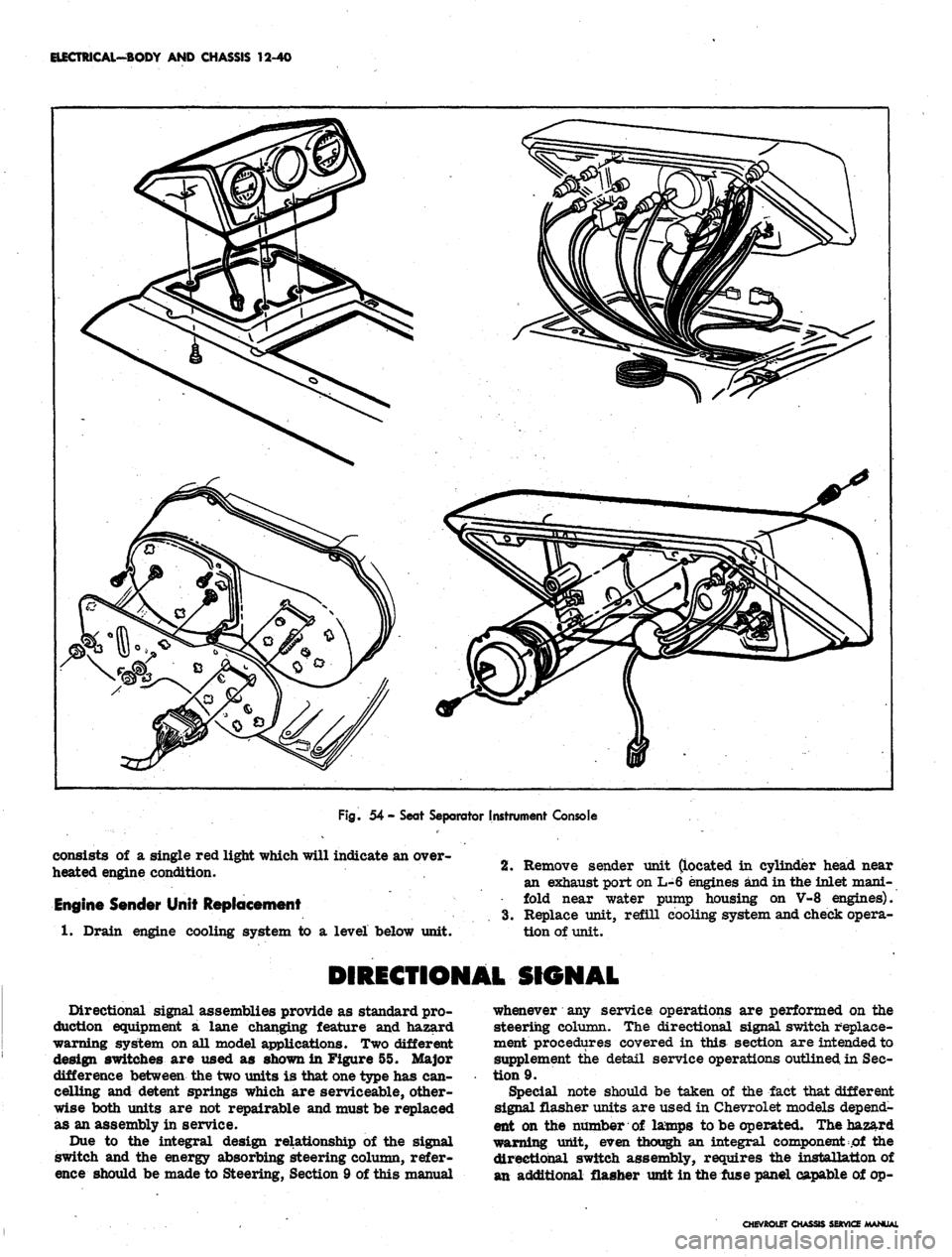
ELECTRICAL-BODY AND CHASSIS 12-40
Fig.
54 - Seat Separator Instrument Console
consists of a single red light which will indicate an over-
heated engine condition.
Engine Sender Unit Replacement
1.
Drain engine cooling system to a level below unit.
2.
Remove sender unit (located in cylinder head near
an exhaust port on L-6 engines and in the inlet mani-
fold near water pump housing on V-8 engines).
3.
Replace unit, refill cooling system and check opera-
tion of unit.
DIRECTIONAL SIGNAL
Directional signal assemblies provide as standard pro-
duction equipment a lane changing feature and hazard
warning system on all model applications. Two different
design switches are used as shown in Figure 55. Major
difference between the two units is that one type has can-
celling and detent springs which are serviceable, other-
wise both units are not repairable and must be replaced
as an assembly in service.
Due to the integral design relationship of the signal
switch and the energy absorbing steering column, refer-
ence should be made to Steering, Section 9 of this manual
whenever any service operations are performed on the
steering column. The directional signal switch replace-
ment procedures covered in this section are intended to
supplement the detail service operations outlined in Sec-
tion 9.
Special note should be taken of the fact that different
signal flasher units are used in Chevrolet models depend-
ent on the number of lamps to be operated. The hazard
warning unit, even though an integral component of the
directional switch assembly, requires the installation of
an additional flasher unit in the fuse panel capable of op-
CHEVROtET CHASSIS SERVICE MANUAL
Page 652 of 659
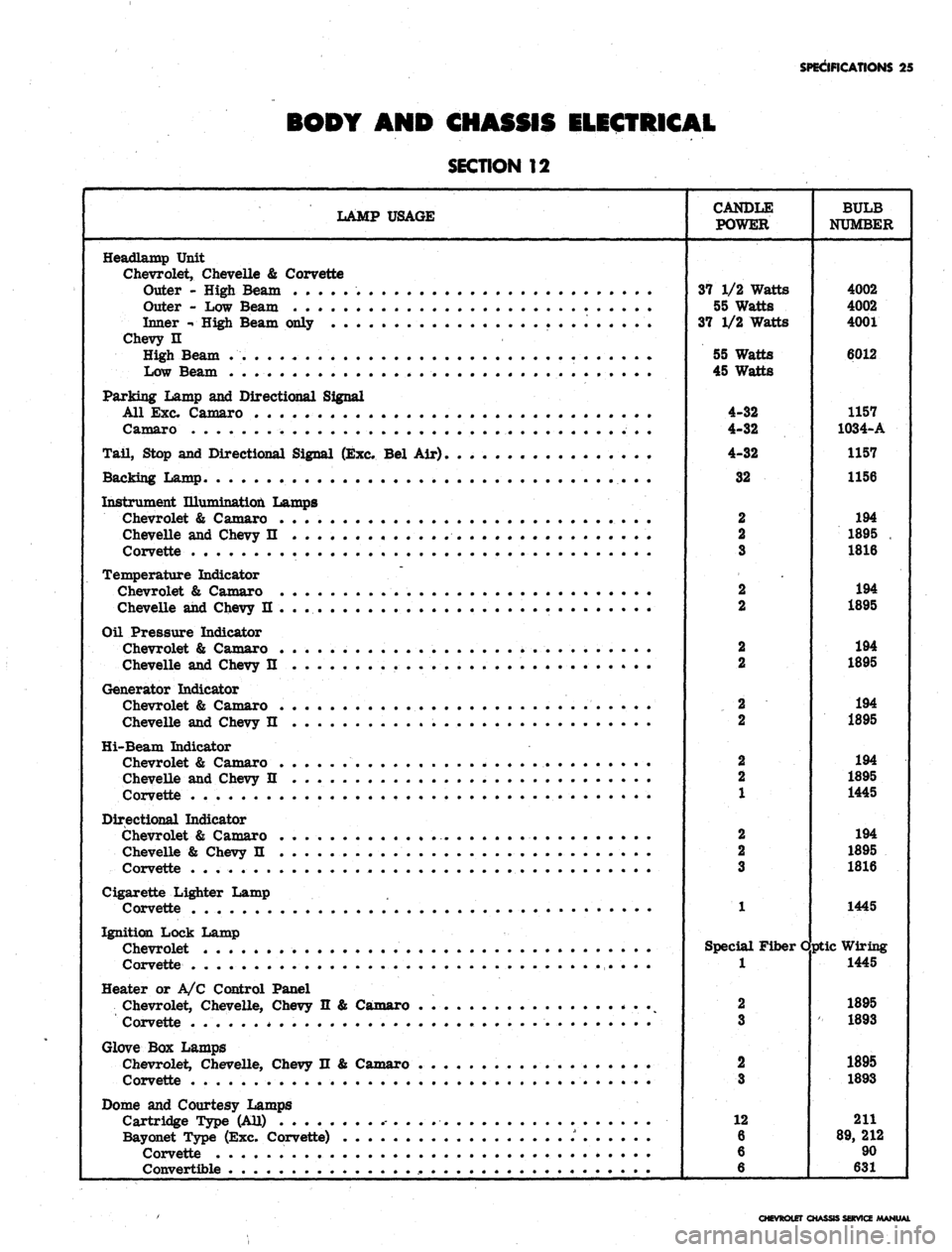
SPECIFICATIONS 25
BODY AND CHASSIS ELECTRICAL
SECTION
12
LAMP USAGE
CANDLE
POWER
BULB
NUMBER
Headlamp Unit
Chevrolet, Chevelle & Corvette
Outer - High Beam
Outer - Low Beam
Inner -• High Beam only
Chevy H
High Beam . .
Low Beam
Parking Lamp and Directional Signal
All Exc. Camaro
Camaro
Tail, Stop and Directional Signal (Exc. Bel Air)
Backing Lamp ••...,
Instrument Illumination Lamps
Chevrolet & Camaro ,
Chevelle and Chevy n
Corvette
Temperature Indicator
Chevrolet & Camaro
Chevelle and Chevy II .............
Oil Pressure Indicator
Chevrolet & Camaro .............
Chevelle and Chevy II
Generator Indicator
Chevrolet & Camaro .
Chevelle and Chevy n ,
Hi-Beam Indicator
Chevrolet & Camaro <
Chevelle and Chevy II
Corvette , . • . ,
Directional Indicator
Chevrolet & Camaro
Chevelle & Chevy II . .
Corvette . .
Cigarette Lighter Lamp
Corvette .
Ignition Lock Lamp
Chevrolet . . .
Corvette . . .
Heater or A/C Control Panel
Chevrolet, Chevelle, Chevy n & Camaro . . .
Corvette . . .
Glove Box Lamps
Chevrolet, Chevelle, Chevy n & Camaro . . .
Corvette . . . . .
Dome and Courtesy Lamps
Cartridge Type (AU)
Bayonet Type (Exc. Corvette) . . .
Corvette ,
Convertible . .
37 1/2 Watts
55 Watts
37 1/2 Watts
55 Watts
45 Watts
4-32
4-32
4-32
Special Fiber
1
2
3
2
3
12
6
6
6
Optic
4002
4002
4001
6012
1157
1034-A
1157
1156
194
1895
.
1816
194
1895
194
1895
194
1895
194
1895
1445
194
1895
1816
1445
Wiring
1445
1895
1893
1895
1893
211
89,
212
90
631
CHEVROLET CHASSIS SERVICE MANUAL
Page 653 of 659
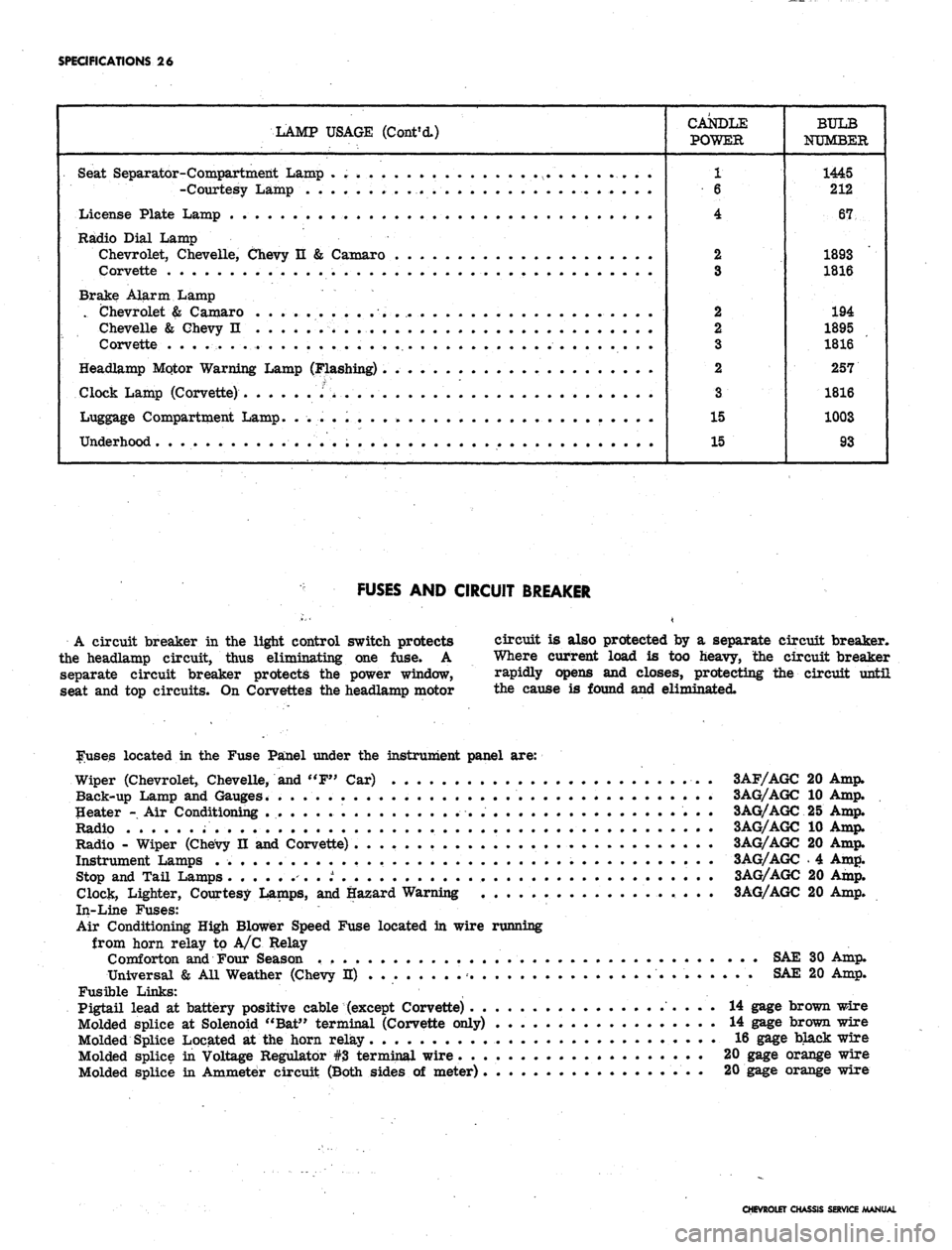
SPECIFICATIONS 26
LAMP USAGE (Cont'd.)
CANDLE
POWER
1
6
4
2
3
2
2
3
2
3
15
15
BULB
NUMBER
1445
212
67
1893
1816
194
1895
1816
257
1816
1003
93
Seat Separator-Compartment Lamp . . . . .
-Courtesy Lamp •
License Plate Lamp . .
Radio Dial Lamp
Chevrolet, Chevelle, Chevy n & Camaro
Corvette
Brake Alarm Lamp
. Chevrolet & Camaro . . .... . .
Chevelle & Chevy n . . . . .'. ;v . . . .
Corvette . . . . . . . .
Headlamp Mqtor Warning Lamp (Flashing) .
Clock Lamp (Corvette) .''> ....
Luggage Compartment Lamp. . ... . . . •
Underhood
FUSES AND CIRCUIT BREAKER
A circuit breaker in the light control switch protects
the headlamp circuit, thus eliminating one fuse. A
separate circuit breaker protects the power window,
seat and top circuits. On Corvettes the headlamp motor
circuit is also protected by a separate circuit breaker.
Where current load is too heavy, the circuit breaker
rapidly opens and closes, protecting the circuit until
the cause is found and eliminated.
louses located in the Fuse Panel under the instrument panel are:
Wiper (Chevrolet, Chevelle, and "F" Car) 3AF/AGC 20 Amp.
Back-up Lamp and Gauges. . . 3AG/AGC 10 Amp.
Heater - Air Conditioning 3AG/AGC 25 Amp.
Radio 3AG/AGC 10 Amp.
Radio - Wiper (Chevy II and Corvette) 3AG/AGC 20 Amp.
Instrument Lamps 3AG/AGC . 4 Amp.
Stop and Tail Lamps ........ t 3AG/AGC 20 Amp.
Clock, Lighter, Courtesy Lamps, and Hazard Warning 3AG/AGC 20 Amp.
In-Line Fuses:
Air Conditioning High Blower Speed Fuse located in wire running
from horn relay to A/C Relay
Comforton and Four Season SAE 30 Amp.
Universal & All Weather (Chevy H) SAE 20 Amp.
Fusible Links: ,
Pigtail lead at battery positive cable (except Corvette) 14 gage brown wire
Molded splice at Solenoid "Bat" terminal (Corvette only) 14 gage brown wire
Molded Splice Located at the horn relay 16 gage black wire
Molded splice in Voltage Regulator #3 terminal wire 20 gage orange wire
Molded splice in Ammeter circuit (Both sides of meter) 20 gage orange wire
CHEVROLET CHASSIS SERVICE MANUAL